Planting decorative viburnum and further care for it for beginners
Viburnum bushes of decorative varieties are outwardly different from the usual viburnum trees. Having planted them in the garden, you can diversify it and give the design a zest. Such viburnum looks good and natural among deciduous and coniferous trees. We will tell further about what the devorative viburnum is good for, how planting and caring for it is carried out.
Characteristics of the main varieties
Most of the popular varieties are not particularly demanding on growing conditions: in order for the tree to develop, it is enough to follow the rules for planting shrubs in the soil and periodically perform special measures for feeding, pruning, and watering.
Buldenezh
Viburnum varieties Buldenezh - an ornamental shrub. It reaches 1.5-3 m in height. A distinctive feature is the appearance of spherical inflorescences in late spring, which have a snow-white hue. It is a frost-resistant variety.
After planting, the tree lives and pleases the eye for about 60 years. It does not bear fruit, its value lies in its attractive appearance during flowering.
The crown of the shrub is 2-4 m wide. The leaves are large, bright green, with notches and veins. The diameter of the inflorescence is up to 15 cm. Under the weight of the ball, the branches of the bush often lean down to the ground.
There are no stamens in the buds, so the tree does not bear fruit.
Dissolving, the Bulldonezh buds have a light green hue, which then turns into cream and slightly pink. When fully opened, the bud becomes a snow-white ball. The flowering tree pleases the eye for about 35 days.
Buldenezh looks good both as a single bush and in group plantings. In the first case, they are planted on a green lawn, next to ponds, benches, gazebos.
Gordovina
This variety performs not only decorative functions: bushes of Gordovina strengthens erosion and shear prone soil thanks to its powerful root system.
This kind of decorative viburnum is also called a fleecy or flour shrub due to the fact that its branches, leaves and shoots are covered with small white villi.
The main characteristics of the variety:
- bush height - up to 6 m;
- crown diameter - 3-4 m;
- leaves - dark green, oblong-oval, up to 18 cm in length;
- berries are small, collected in oval clusters. Appear after the fall of the inflorescences. The berries are green at first, then gradually turn red, and then turn black;
- life expectancy is about 60 years.
When fully ripe, the berries are black in color, juicy and rather sweet in taste. The berries of the red Gordovin viburnum are not eaten, since at this stage they are not ripe, they have a sour and tart taste.
The flowering period starts in June and lasts 2-4 weeks.
The plant is resistant to droughts and frosts, as well as diseases, including viburnum leaf beetles.
Three-bladed
The shrub originated from North America. Usually grows in the area of banks near streams and rivers, in moist forests, among dense bushes.
Culture characteristics:
- height - up to 4 m;
- crown diameter - 2.5 m or more;
- leaves are light green in color, three-lobed, with a rounded or truncated base;
- flowers - creamy white, with long stamens, corymbose inflorescences. Flowering begins in early summer and lasts about a week;
- fruits are spherical, bright scarlet in color, 1 cm in diameter. Edible berries are used in cooking, taste like red currants.They ripen in September-October.
The three-bladed decorative viburnum is resistant to diseases and low air temperatures, as well as winds.
Toothed
This type of ornamental tree naturally grows in damp places, in swamps.
The height of one bush reaches 5 m.The leaves are almost round, with a length of 5-10 cm.The diameter of the crown is 5.5 m.
Flowers are small in size, collected in inflorescences up to 6 cm in diameter. Flowers appear in the last spring or first summer month.
The ripe fruits of toothed viburnum are dark blue and small in size. They taste bitter, so they are not used for food, but birds willingly eat them.
This variety loves warmth and light, but is unpretentious to the soil composition. It tolerates winter and short-term drought well.
Wright
Initially, this variety was distributed in the territories of Korea, Japan, the Kuril Islands, Sakhalin.
The height of the bush reaches 3 m. The leaves are ovoid, 3-7 cm long, pointed. The color of the leaves is dark green, slightly lighter in the lower part.
The bush blooms in late spring and early summer.
The fruits ripen in September-October. The berries are spherical, bright red, juicy.
Wright is not a winter-hardy variety of viburnum, so it is recommended to plant bushes in places protected from strong winds.
Seat selection
Viburnum trees of decorative varieties love high humidity, so they try to plant them closer in water bodies and other places with high humidity. But if this is not possible, then a fairly dry soil will do, but under such conditions it is important to ensure abundant and regular watering.
Another condition for the successful cultivation of decorative viburnum is the shade of the site. Although trees love sunshine, growth will slow down under constant exposure.
Viburnum has powerful branched roots, so it can be planted on slopes and slopes: the trees will well strengthen the soil in these places.
Optimal disembarkation time
You can plant trees on the site in late autumn and early spring. The best option is the spring period: at this time of the year, the trees adapt better to the environment and develop more intensively.
In the spring, it is better to use the layering method, since when planting cuttings, viburnum takes root worse.
Growing instructions
For disembarkation, you need a shoot of a young growth that has grown on the side. To do this, it must be carefully separated from the bush so as not to damage it.
If you use a cutting, it will be much more difficult to plant a shrub. First you need to cut off a branch of a young shoot (there should be about 8 buds on it), plant it in a greenhouse in fertile soil. The air temperature must be high. Water in moderation.
Leave the stalk until spring (subject to planting in a greenhouse in autumn). Then you can plant it in the ground.
You should not plant the bushes in open ground in the rain or at low temperatures.
Landing
You need to plant like this:
- dig a depression in the ground with a diameter of half a meter to 70 cm, half a meter down;
- lay the crushed stone on the bottom with a dense layer, which will act as a drainage;
- pour a layer of sand (10-15 cm is enough);
- fill the hole with soil. The optimal composition is 4 buckets of compost mixed with 2-3 glasses of wood ash and a glass of nitrophoska;
- immerse the bush in a hole filled with earth, water and cover with a layer of sawdust or humus. The neck of the root should be deepened by about 5 cm.
After planting, it is recommended to cut the bush at a height of 20 cm, at the end of July - to pinch the overgrown young shoots of the tree. In the future, every year, the lateral branches of the shrub need to be slightly shortened in the summer, upon completion of flowering, and also to thin out the central part, avoiding excessive thickening.
Care features
The main aspects of caring for decorative viburnum trees:
- watering. The tree prefers moisture, so the trees need to be watered frequently with sufficient amounts of water. Droughts require more attention. It is important to ensure that the ground around the trunk of the bush does not dry out.At the end of autumn, before the onset of severe frosts, you need to water the trees abundantly, in order to avoid dehydration in the winter;
- top dressing. You need to start feeding in the second year after planting a tree. Do this work 2 times: before the beginning of the growing season and before the leaves fall. In the spring, fertilizer is applied, consisting of 50 g of nitrogen, 40 g of phosphorus and 30 g of potassium per m2. In the autumn period, the composition for feeding consists only of phosphorus and potassium (20 g and 15 g, respectively, per 1 m2). Fertilizers need to be scattered superficially, then dig up, mulch and water the soil;
- pruning. Manipulation is required in order to rejuvenate the tree and form the crown. It is recommended to cut off all old branches at a height of 15-20 cm from the soil surface. The branches should be cut in the spring, before the start of sap flow, or in the fall, after the leaves fall. It is necessary to carry out such "rejuvenating" procedures only after the second year after planting the tree in the ground, otherwise it will not benefit the shrub. If there is a desire to form a bush with several trunks, then it must be cut off at a young age to the level of the stump, leaving about 20 cm. Thanks to this manipulation, the growth of lateral branches is stimulated.
After the trunk of the decorative viburnum tree has developed enough, it must be tied to a support.
It is necessary to regularly monitor that the trees are not exposed to the invasion of pests.
Most types of ornamental viburnum are characterized by resistance to low temperatures, but it is necessary to prepare the bushes for winter. In a temperate climatic zone, you need to mulch the trunk circle - this will prevent the root system from freezing.
Before the onset of the first frost, you need to sprinkle this circle with straw or peat. Young bushes up to three years old are recommended to be wrapped in burlap or other similar material.
Reproduction of decorative viburnum
You can breed shrubs in the following ways:
- layering. This method is suitable if a tree is already growing in the garden. Near the bush, you need to dig a hole about 15 cm deep. On the bark of the tree, at the points of contact with the ground, make small cuts, which must be treated with growth stimulants. The lower shoot of the viburnum is bent to the landing site and pinned with a bracket. Then sprinkle with a layer of soil, compact. Watered on top, the soil must be constantly moistened. If the temperature and other conditions are favorable, then by the fall the shoots of the viburnum take root. You can separate the layers from the main bush and plant them separately after a couple of years;
- by cuttings. This process takes effort and time. Planting material is taken during the summer pruning of the bush. In order for the tree to take root better, cuttings with one internode are chosen. In June, shoots are cut from the bush at the age of one year, 7-8 cm long. They are planted in humus and left in a greenhouse, covered with a film. The planting material is provided with moderate watering with water not too high temperature. In such conditions, the cuttings must be kept until next spring and only after that they must be planted in open ground;
- division. Thanks to this method, 2 or 3 are obtained from one young plant. Having dug up a viburnum bush in spring or autumn, divide it with a garden knife so that each of the daughter parts gets roots and several growth buds. Rub the slices with charcoal. This method allows the split parts to be immediately seated in a permanent place. This method of reproduction can be practiced only until the buds have not yet swollen on the tree.
When planting bushes, make sure that they are immersed in the soil layer in a strictly vertical position.
The cultivation of decorative viburnum from seeds is rarely practiced, because they germinate for a long time, about two years. To speed up this process, freshly harvested seeds need to be folded into nylon stockings with moistened sawdust inside.Leave for 60 days at room temperature.
When the seeds begin to germinate, you need to put them on the bottom shelf of the refrigerator and leave them for another month. After that, plant them in boxes to a depth of 3-4 cm. It remains to wait for the shoots.
Possible problems and solutions
When growing ornamental viburnum, it is necessary to treat the shrubs with pest control agents in time. The trees are often affected by the leaf beetle, which destroys all the foliage. You can cope with it with chlorophos 0.2%, which you need to spray the entire bush. Already damaged leaves must be torn off and burned.
A good prevention of the appearance of powdery mildew are folk remedies: infusions based on onions, garlic, tobacco.
Aphids damage not only the leaves, but also the flowers of the tree. To cope with it, it is worth using the drug Inta-Vir. Laundry soap diluted with water is suitable from improvised means. Apply the resulting liquid using a container equipped with a spray gun, do not remove residues after processing.
Some gardeners are faced with the lack of inflorescences on trees. The main reason for this is the wrong place for planting trees. In strong shade, the bush loses its decorative effect. Exposure to the sun's rays also negatively affects his condition.
Experienced gardeners recommendations
Novice gardeners should heed the advice of more experienced colleagues who know the intricacies of growing decorative viburnum. Here are the most valuable ones:
- since the trees of decorative viburnum are susceptible to the invasion of ants that grow aphids on them, a one-time treatment of the shoots with an insecticide preparation should be performed;
- after the formation of the trunk, it is imperative to tie the bush to the support so that it is not damaged by gusts of wind;
- in the fall, after the completion of leaf fall, you need to remove the leaves along with the old mulch;
- 2-3 hilling should be carried out over the summer.
There are dozens of varieties of decorative viburnum. They decorate the site, land both singly and in groups. They need a watering and feeding regime.
Watch a video about the buldonezh variety viburnum:



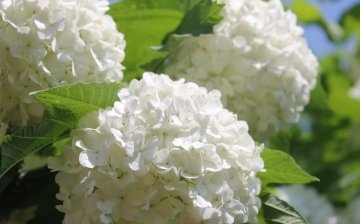
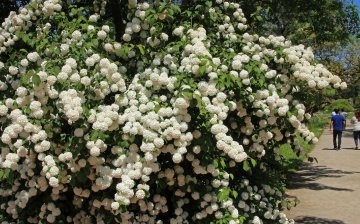




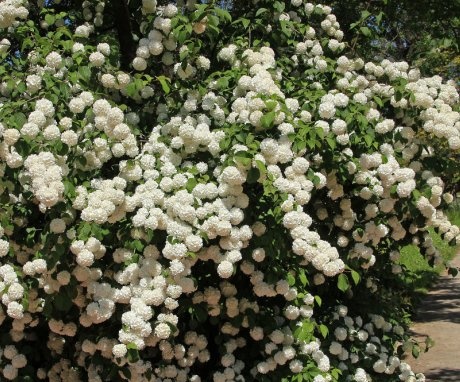
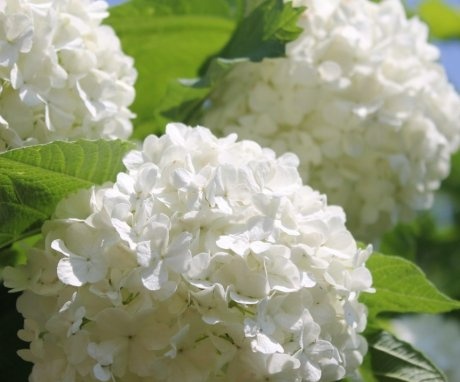
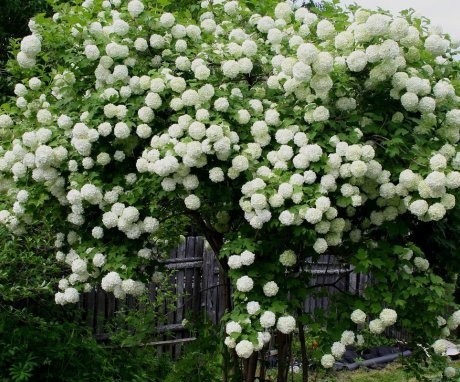
Very beautiful ornamental shrub of the Buldonezh variety. I will breed decorative viburnum on the site with cuttings. They are generally well accepted and retain all varietal qualities.